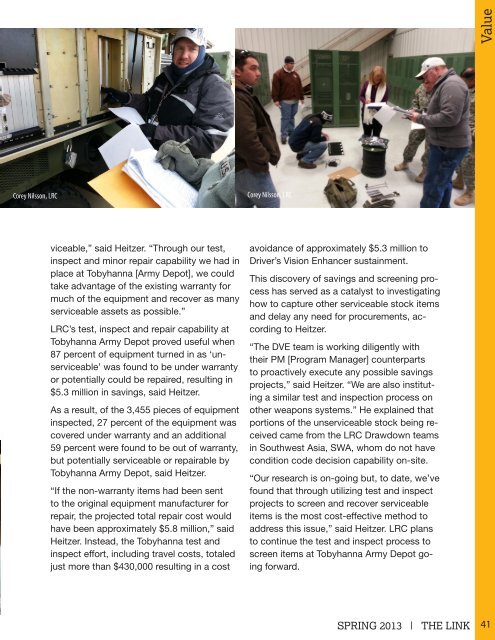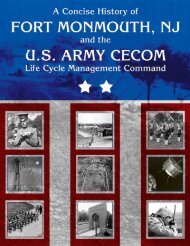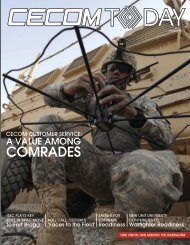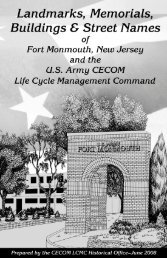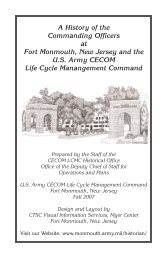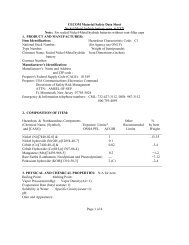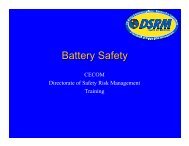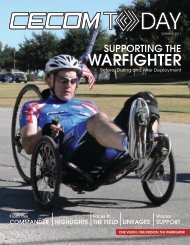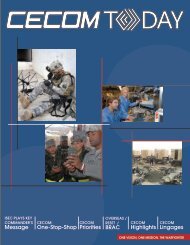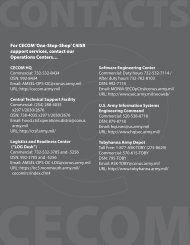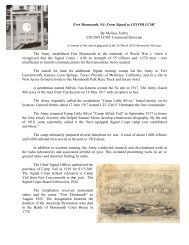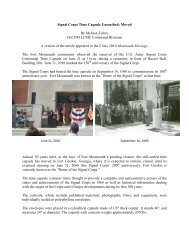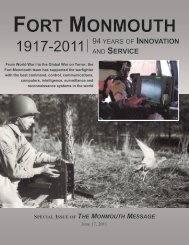download PDF version - CECOM - U.S. Army
download PDF version - CECOM - U.S. Army
download PDF version - CECOM - U.S. Army
Create successful ePaper yourself
Turn your PDF publications into a flip-book with our unique Google optimized e-Paper software.
Value<br />
Corey Nilsson, LRC<br />
Corey Nilsson, LRC<br />
viceable,” said Heitzer. “Through our test,<br />
inspect and minor repair capability we had in<br />
place at Tobyhanna [<strong>Army</strong> Depot], we could<br />
take advantage of the existing warranty for<br />
much of the equipment and recover as many<br />
serviceable assets as possible.”<br />
LRC’s test, inspect and repair capability at<br />
Tobyhanna <strong>Army</strong> Depot proved useful when<br />
87 percent of equipment turned in as ‘unserviceable’<br />
was found to be under warranty<br />
or potentially could be repaired, resulting in<br />
$5.3 million in savings, said Heitzer.<br />
As a result, of the 3,455 pieces of equipment<br />
inspected, 27 percent of the equipment was<br />
covered under warranty and an additional<br />
59 percent were found to be out of warranty,<br />
but potentially serviceable or repairable by<br />
Tobyhanna <strong>Army</strong> Depot, said Heitzer.<br />
“If the non-warranty items had been sent<br />
to the original equipment manufacturer for<br />
repair, the projected total repair cost would<br />
have been approximately $5.8 million,” said<br />
Heitzer. Instead, the Tobyhanna test and<br />
inspect effort, including travel costs, totaled<br />
just more than $430,000 resulting in a cost<br />
avoidance of approximately $5.3 million to<br />
Driver’s Vision Enhancer sustainment.<br />
This discovery of savings and screening process<br />
has served as a catalyst to investigating<br />
how to capture other serviceable stock items<br />
and delay any need for procurements, according<br />
to Heitzer.<br />
“The DVE team is working diligently with<br />
their PM [Program Manager] counterparts<br />
to proactively execute any possible savings<br />
projects,” said Heitzer. “We are also instituting<br />
a similar test and inspection process on<br />
other weapons systems.” He explained that<br />
portions of the unserviceable stock being received<br />
came from the LRC Drawdown teams<br />
in Southwest Asia, SWA, whom do not have<br />
condition code decision capability on-site.<br />
“Our research is on-going but, to date, we’ve<br />
found that through utilizing test and inspect<br />
projects to screen and recover serviceable<br />
items is the most cost-effective method to<br />
address this issue,” said Heitzer. LRC plans<br />
to continue the test and inspect process to<br />
screen items at Tobyhanna <strong>Army</strong> Depot going<br />
forward.<br />
SPRING 2013 | THE LINK 41 41


